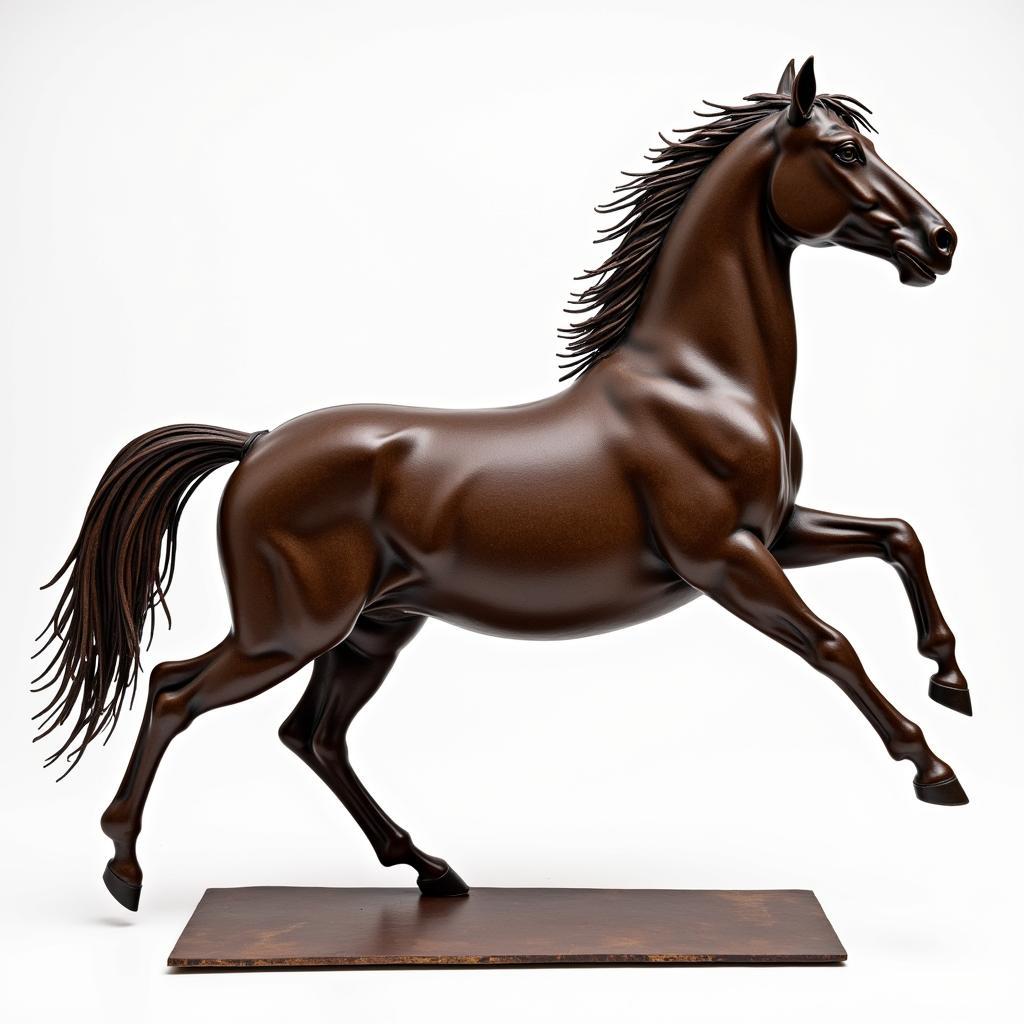Horse sculptures have captivated art enthusiasts and equestrians for centuries. These three-dimensional works of art, crafted from materials like bronze, marble, and wood, capture the grace, power, and spirit of horses in stunning detail. From ancient cave paintings to modern masterpieces, the enduring fascination with horse sculpture reflects our deep connection to these magnificent creatures.
A Journey Through Time: Exploring the History of Horse Sculpture
The earliest known depictions of horses in art date back to the Paleolithic era. Cave paintings in Lascaux, France, showcase horses with incredible realism, highlighting their importance even in prehistoric societies. As civilizations evolved, so did their artistic representations of horses. Ancient Greek sculptures, renowned for their anatomical accuracy and flowing lines, often depicted horses in motion, pulling chariots or carrying triumphant warriors.
The Romans, too, were avid equestrians and incorporated horse sculptures into their art and architecture. Roman horse sculptures often served commemorative purposes, honoring emperors and military leaders. These grand statues, typically cast in bronze, conveyed a sense of power and authority.
The Renaissance and Beyond: Horse Sculpture as Art
During the Renaissance, horse sculpture experienced a resurgence in popularity. Artists like Donatello and Leonardo da Vinci brought a renewed sense of naturalism and anatomical detail to their equine subjects. Da Vinci’s unfinished masterpiece, the “Gran Cavallo,” was intended to be the largest equestrian statue ever created, a testament to his ambition and fascination with horses.
The Baroque period saw a surge in dramatic and dynamic horse sculptures. Gian Lorenzo Bernini’s “Equestrian Statue of Louis XIV” epitomizes the Baroque style, with its rearing horse and swirling drapery, conveying a sense of movement and theatricality.
Modern and Contemporary Horse Sculpture
The 20th and 21st centuries have witnessed a diverse range of styles and materials used in horse sculpture. From abstract interpretations to realistic representations, artists continue to push the boundaries of this timeless art form. Bronze remains a popular choice, but artists are also experimenting with materials like steel, glass, and recycled materials, creating unique and thought-provoking works.
Contemporary horse sculptures often explore themes beyond mere physical representation. Artists may use the horse as a symbol of freedom, strength, or the human-animal bond. These sculptures invite viewers to contemplate their own relationships with horses and the natural world.
Choosing the Perfect Horse Sculpture for Your Home or Stable
Whether you’re an experienced collector or simply looking to add a touch of equestrian elegance to your space, there’s a horse sculpture out there for you. Consider the style, material, and size that best suits your taste and surroundings. A small bronze sculpture might be perfect for a bookshelf, while a life-size fiberglass horse could become a stunning focal point in your garden.
 abstract-steel-sculpture-of-horse-in-motion
abstract-steel-sculpture-of-horse-in-motion
When selecting a horse sculpture, think about the emotions you want it to evoke. Do you prefer a sense of peace and tranquility, or something bold and powerful? Do you want a realistic portrayal or a more abstract interpretation? Ultimately, the perfect horse sculpture is one that speaks to you on a personal level.
Conclusion: Celebrating the Timeless Appeal of Horse Sculpture
Horse sculpture, with its rich history and enduring appeal, continues to inspire awe and admiration. From the earliest cave paintings to modern masterpieces, these three-dimensional works of art capture the essence of horses in all their beauty, power, and grace. Whether you’re drawn to the intricate details of classical sculpture or the bold statements of contemporary art, horse sculptures offer a timeless and captivating way to celebrate our enduring fascination with these magnificent creatures.
FAQs
What is the most common material used for horse sculptures?
Bronze is the most common material used for horse sculptures due to its durability, ability to capture fine details, and timeless aesthetic.
Are there any famous horse sculptures in the United States?
Yes, the United States boasts several iconic horse sculptures, including the “General Sherman” monument in New York City’s Central Park and the “Crazy Horse Memorial” in South Dakota.
How can I care for a bronze horse sculpture?
Bronze sculptures require minimal maintenance. Regular dusting and occasional cleaning with a soft cloth and specialized bronze cleaner will help preserve their beauty.
Need help finding the perfect horse sculpture?
Contact Justus Horses USA today! Call us at 0772127271, email us at [email protected], or visit our location at QGM2+WX2, Vị Trung, Vị Thuỷ, Hậu Giang, Việt Nam. Our team of experts is available 24/7 to assist you.